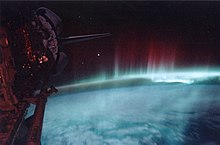STS-39
Launch was originally scheduled for March 9, 1991, but during processing work at Pad LC-39A, significant cracks were found on all four lug hinges on the two external tank umbilical door drive mechanisms.The mission was again postponed when, during prelaunch external tank loading, a transducer on high-pressure oxidizer turbopump for main engine number three showed readings out of specification.Unclassified payload included Air Force Program-675 (AFP-675); Infrared Background Signature Survey (IBSS) with Critical ionization velocity (CIV), Chemical Release Observation (CRO) and Shuttle pallet satellite-II (SPAS-II) experiments; and Space Test Payload-1 (STP-1).Carried in the orbiter's cargo bay were: Air Force Program-675 (AFP-675); Infrared Background Signature Survey (IBSS); Space Test Program-01 (STP-01); and the MPEC.The high orbital inclination of the mission, 57.01° with respect to the equator, allowed the crew to fly over most of Earth's large land masses and observe and record environmental resources and problem areas.
Critical ionization velocitySpace Transportation SystemCOSPAR IDSATCAT no.Space ShuttleDiscoveryMichael L. CoatsL. Blaine HammondGregory J. HarbaughDonald R. McMonagleGuion BlufordCharles L. VeachRichard HiebKennedyLC-39ARockwell InternationalSLF Runway 15Geocentric orbitLow Earth orbitPerigee altitudeApogee altitudeInclinationPeriodShuttle pallet satelliteRadiation Monitoring EquipmentHarbaughMcMonagleHammondBlufordSpace Shuttle programSTS-37STS-40Space Shuttle DiscoveryU.S. Department of DefensePositionMichael CoatsAurora australisVehicle Assembly BuildingOrbiter Processing FacilityColumbiatransducerAir Force Program-675wavelengthsinfraredfar ultravioletCanadarmliquid heliumtape recordersKu-bandground stationorbital inclinationequatorKennedy Space CenterFloridaEdwards Air Force BaseCaliforniaList of human spaceflightsList of Space Shuttle missionsMilitarization of spaceOutline of space scienceOrbital Maneuvering Systemreaction control systemJohnson Space Centerpublic domainWayback MachineSTS-41-DSTS-51-ASTS-51-CSTS-51-DSTS-51-GSTS-51-ISTS-26STS-29STS-33STS-31STS-41STS-48STS-42STS-53STS-56STS-51STS-60STS-64STS-63STS-70STS-82STS-85STS-91STS-95STS-96STS-103STS-92STS-102STS-105STS-114STS-121STS-116STS-120STS-124STS-119STS-128STS-131STS-133Steven F. Udvar-Hazy CenterWashington, D.C.Destiny in SpaceU.S. Space Shuttle missions(crews)Approach and Landing TestsSTS-41-BSTS-41-CSTS-41-GSTS-51-BSTS-51-FSTS-51-JSTS-61-ASTS-61-BSTS-61-CSTS-51-LSTS-27STS-30STS-28STS-34STS-32STS-36STS-38